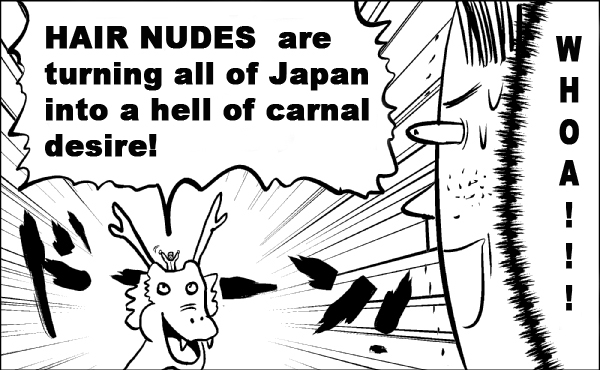religion (Page 4)
It’s all in the name of Japanese culture and tradition.
Serendipity has given RocketNews24 an inside look at the controversial religion currently making headlines: Happy Science.
The butsudan, a traditional religious home furnishing, is the latest unlikely muse for Japan’s continuing anthropomorphization craze.
Just because your loved ones have moved on from this world doesn’t mean they won’t appreciate a little cuteness.
Priests struggling to humanely keep cat population under control, asking for visitors’ help.
A Muslim man being detained at a Yokohama immigration center was served pork and has gone on a hunger strike in protest.
If you’re one of the many people who’d rather be playing video games than discussing religion with a stranger, this is one trick you’ll want to know.
There’s no better way to look after the roads than with built-in protection from one of Japan’s most revered deities.
Today we’re introducing you to the basics of Japanese Buddhism, plus highlighting some of the Buddhist images you’ll see in Japan and help you distinguish them from Shinto ones.
In Japan, there truly is an all-singing, all-dancing “idol” group for everything. From plus-sized beauties to macho men and octogenarians, if you’ve got a unique message and a catchy tune, there’ll be a niche audience out there waiting to share your next video and dance along with glow sticks at your next performance.
Just when we thought the happy-go-lucky, free-for-all nature of the amateur idol world had no boundaries, it seems there is one line that can’t be crossed: schoolgirls and religion. Meet the “Num-Num Girls”, a Buddhism-based schoolgirl pop group that has been shut down for becoming too popular.



















 7-Eleven Japan’s ramen-cooking robot whipped us up a bowl of noodles【Taste test】
7-Eleven Japan’s ramen-cooking robot whipped us up a bowl of noodles【Taste test】 Is it rude to sing along at concerts in Japan? We ask a pro musician for his take
Is it rude to sing along at concerts in Japan? We ask a pro musician for his take Mr. Sato accosts award-winning actor Hideaki Ito【Interview】
Mr. Sato accosts award-winning actor Hideaki Ito【Interview】 Japanese tough guy fashion starter pack: Testing the Birth Japan lucky bag【Photos】
Japanese tough guy fashion starter pack: Testing the Birth Japan lucky bag【Photos】 Studio Ghibli unveils My Neighbour Totoro miniature house model
Studio Ghibli unveils My Neighbour Totoro miniature house model Yoshinoya adds first-ever chain-wide ramen with new beef and pork-broth noodle hot pot meals
Yoshinoya adds first-ever chain-wide ramen with new beef and pork-broth noodle hot pot meals 7-Eleven now sells rice burgers in Japan, blurring the line between fast and convenience store food
7-Eleven now sells rice burgers in Japan, blurring the line between fast and convenience store food How much should we give in a New Year’s otoshidama without looking like a jerk?
How much should we give in a New Year’s otoshidama without looking like a jerk? More Than a Capsule Stay: Why Solo Travelers Choose “global cabin Yokohama Chinatown”
More Than a Capsule Stay: Why Solo Travelers Choose “global cabin Yokohama Chinatown” Hello Kitty Choco Egg figures are an adorable trip through three periods of Japanese pop culture【Pics】
Hello Kitty Choco Egg figures are an adorable trip through three periods of Japanese pop culture【Pics】 7-Eleven Japan starts new temporary luggage storage service in over 300 branches
7-Eleven Japan starts new temporary luggage storage service in over 300 branches Disillusionment at Tsukiji’s tourist-target prices led us to a great ramen restaurant in Tokyo
Disillusionment at Tsukiji’s tourist-target prices led us to a great ramen restaurant in Tokyo Japan may add Japanese language proficiency, lifestyle classes to permanent foreign resident requirements
Japan may add Japanese language proficiency, lifestyle classes to permanent foreign resident requirements Starbucks Japan releases new zodiac chilled cup drink for 2026
Starbucks Japan releases new zodiac chilled cup drink for 2026 Lacquerware supplier to emperor of Japan and Pokémon team up for new tableware
Lacquerware supplier to emperor of Japan and Pokémon team up for new tableware Starbucks teams up with 166-year-old Kyoto doll maker for Year of the Horse decorations【Photos】
Starbucks teams up with 166-year-old Kyoto doll maker for Year of the Horse decorations【Photos】 Starbucks on a Shinkansen bullet train platform: 6 tips for using the automated store in Japan
Starbucks on a Shinkansen bullet train platform: 6 tips for using the automated store in Japan Is this the most relaxing Starbucks in Japan?
Is this the most relaxing Starbucks in Japan? Large amount of supposed human organs left in Osaka marketplace
Large amount of supposed human organs left in Osaka marketplace Tokyo’s Tsukiji sushi neighborhood asks tour groups to stay away for the rest of the month
Tokyo’s Tsukiji sushi neighborhood asks tour groups to stay away for the rest of the month Japan’s human washing machines will go on sale to general public, demos to be held in Tokyo
Japan’s human washing machines will go on sale to general public, demos to be held in Tokyo Japanese train company is letting fans buy its actual ticket gates for their homes
Japanese train company is letting fans buy its actual ticket gates for their homes Tokyo considering law requiring more trash cans following litter increase in heavily touristed area
Tokyo considering law requiring more trash cans following litter increase in heavily touristed area Nintendo’s Kirby now delivering orders at Kura Sushi restaurants, but not in Japan
Nintendo’s Kirby now delivering orders at Kura Sushi restaurants, but not in Japan Tokyo event lets you travel back in time, for free, to celebrate 100 years since Showa era start
Tokyo event lets you travel back in time, for free, to celebrate 100 years since Showa era start Sanrio theme park in Japan announces plans to expand into a Sanrio resort
Sanrio theme park in Japan announces plans to expand into a Sanrio resort Survey asks foreign tourists what bothered them in Japan, more than half gave same answer
Survey asks foreign tourists what bothered them in Japan, more than half gave same answer Japan’s deadliest food claims more victims, but why do people keep eating it for New Year’s?
Japan’s deadliest food claims more victims, but why do people keep eating it for New Year’s? We deeply regret going into this tunnel on our walk in the mountains of Japan
We deeply regret going into this tunnel on our walk in the mountains of Japan Studio Ghibli releases Kodama forest spirits from Princess Mononoke to light up your home
Studio Ghibli releases Kodama forest spirits from Princess Mononoke to light up your home Major Japanese hotel chain says reservations via overseas booking sites may not be valid
Major Japanese hotel chain says reservations via overseas booking sites may not be valid Put sesame oil in your coffee? Japanese maker says it’s the best way to start your day【Taste test】
Put sesame oil in your coffee? Japanese maker says it’s the best way to start your day【Taste test】 The top 10 annoying foreign tourist behaviors on trains, as chosen by Japanese people【Survey】
The top 10 annoying foreign tourist behaviors on trains, as chosen by Japanese people【Survey】 No more using real katana for tourism activities, Japan’s National Police Agency says
No more using real katana for tourism activities, Japan’s National Police Agency says Starbucks Japan reveals new sakura drinkware collection, inspired by evening cherry blossoms
Starbucks Japan reveals new sakura drinkware collection, inspired by evening cherry blossoms Yoshinoya adds first-ever chain-wide ramen with new beef and pork-broth noodle hot pot meals
Yoshinoya adds first-ever chain-wide ramen with new beef and pork-broth noodle hot pot meals 7-Eleven now sells rice burgers in Japan, blurring the line between fast and convenience store food
7-Eleven now sells rice burgers in Japan, blurring the line between fast and convenience store food How much should we give in a New Year’s otoshidama without looking like a jerk?
How much should we give in a New Year’s otoshidama without looking like a jerk? More Than a Capsule Stay: Why Solo Travelers Choose “global cabin Yokohama Chinatown”
More Than a Capsule Stay: Why Solo Travelers Choose “global cabin Yokohama Chinatown” Hello Kitty Choco Egg figures are an adorable trip through three periods of Japanese pop culture【Pics】
Hello Kitty Choco Egg figures are an adorable trip through three periods of Japanese pop culture【Pics】 More people in Japan quit sending New Year’s cards and many have started to regret it
More people in Japan quit sending New Year’s cards and many have started to regret it When is the right time for a love confession in Japan?
When is the right time for a love confession in Japan? McDonald’s Korea now serving up Hello Kitty in cute Sanrio costumes
McDonald’s Korea now serving up Hello Kitty in cute Sanrio costumes 7-Eleven Japan starts new temporary luggage storage service in over 300 branches
7-Eleven Japan starts new temporary luggage storage service in over 300 branches Sailor Moon wedding reception reservations start, floral arrangements, table settings shown off
Sailor Moon wedding reception reservations start, floral arrangements, table settings shown off Japan’s buzzword of the year nominees: A great way to learn and be baffled by Japanese vocabulary
Japan’s buzzword of the year nominees: A great way to learn and be baffled by Japanese vocabulary Large amount of supposed human organs left in Osaka marketplace
Large amount of supposed human organs left in Osaka marketplace Sixth grade homeroom teacher in trouble for explaining to students that “naked women = money”
Sixth grade homeroom teacher in trouble for explaining to students that “naked women = money”